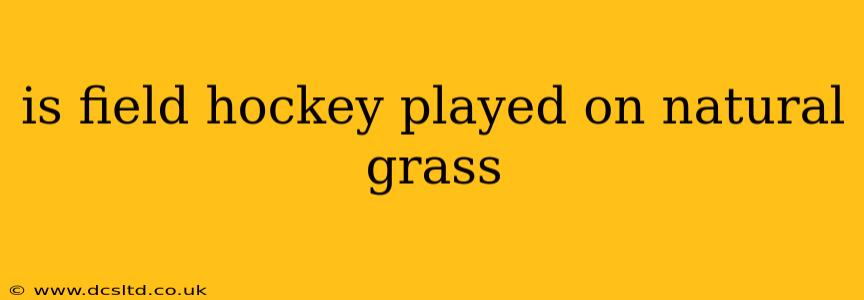Field hockey, a fast-paced and skillful sport, has a rich history intertwined with its traditional playing surface: natural grass. While artificial turf has gained significant popularity, the question of whether field hockey is exclusively played on natural grass remains a complex one. This article delves into the specifics, exploring the pros and cons of both natural and artificial surfaces and examining the current state of the game.
What is the Traditional Playing Surface for Field Hockey?
Historically, field hockey was played almost exclusively on natural grass. This tradition dates back centuries, and the game's development was intrinsically linked to the characteristics of this natural surface. The unevenness, natural give, and varied playing conditions all contributed to the unique challenges and strategic considerations of the sport. Many purists still consider natural grass the ideal playing surface, emphasizing its connection to the game's heritage.
Is Field Hockey Played on Artificial Turf?
Yes, the vast majority of high-level international and professional field hockey matches are now played on artificial turf, often referred to as artificial grass or water-based turf. This shift is largely due to several advantages artificial turf offers:
-
Consistent Playing Conditions: Unlike natural grass, which can vary significantly in condition depending on weather, maintenance, and time of year, artificial turf provides a consistently even and predictable playing surface. This makes for a fairer game and allows for more consistent performance from players.
-
Improved Drainage: Artificial turf with its specialized drainage systems significantly reduces the impact of rain, allowing play to continue even after significant rainfall. This is a major advantage over natural grass, which can become waterlogged and unplayable.
-
Durability and Longevity: Artificial turf is far more durable than natural grass, requiring less maintenance and offering a longer lifespan. This translates to cost savings for organizations and facilitates more consistent playing opportunities.
-
Reduced Risk of Injury: While injuries can still occur, the consistent and even surface of artificial turf can reduce the risk of certain types of injuries that might be caused by uneven natural grass, such as ankle sprains.
What are the Pros and Cons of Natural Grass for Field Hockey?
Pros:
- Traditional and Aesthetically Pleasing: Natural grass provides a traditional and aesthetically pleasing playing surface, deeply connected to the historical roots of the sport. Many players and spectators prefer the look and feel of natural grass.
- Natural Cushioning: While this can also be a drawback (see below), the natural give of grass provides a degree of cushioning that can be beneficial to players' joints and reduce impact.
Cons:
- Inconsistent Playing Conditions: The condition of natural grass is highly dependent on weather, requiring significant maintenance to ensure consistent playability. This can lead to unpredictable playing conditions.
- Maintenance Intensive: Maintaining a natural grass pitch requires significant time, resources, and expertise. This is a significant cost factor for organizations.
- Increased Risk of Injuries (in some cases): Uneven surfaces can increase the risk of certain injuries, particularly ankle sprains and muscle strains. Poor drainage can lead to waterlogged conditions, increasing the risk of slips and falls.
What are the Pros and Cons of Artificial Turf for Field Hockey?
Pros: (Many of these were covered above, but are summarized here for clarity)
- Consistent Playing Surface: Ensures fair play and predictable performance regardless of weather.
- Excellent Drainage: Allows for play even after heavy rainfall.
- Reduced Maintenance: Requires less time, resources, and expertise to maintain.
- Increased Durability: Longer lifespan leading to cost savings in the long run.
- Potentially Reduced Injury Risk (in some cases): A consistent surface can reduce some injury risks.
Cons:
- Higher Initial Cost: Installing artificial turf has a significant upfront cost.
- Environmental Concerns: The manufacturing and disposal of artificial turf raise environmental concerns. Some materials used can contain harmful substances.
- Heat Retention: Artificial turf can retain heat, making it uncomfortable to play on during hot weather.
- Artificial Feel: Some players find the artificial feel of the turf less enjoyable than natural grass.
Which Surface is Better for Playing Field Hockey?
The "better" surface is subjective and depends on various factors, including budget, climate, playing level, and personal preference. While artificial turf has become the dominant surface in high-level competition due to its consistency and maintainability, natural grass retains its appeal for many due to its traditional feel and aesthetic qualities. The ideal surface often depends on the specific needs and priorities of the organization or players involved.
Does the Surface Affect the Gameplay?
Absolutely. The surface significantly impacts gameplay. The ball's speed, bounce, and overall trajectory differ on natural grass and artificial turf. Tactics and playing styles often adapt to suit the characteristics of the specific playing surface. Players need to adjust their skills and techniques according to the surface.
Where is Field Hockey Mostly Played Today?
While natural grass remains a significant presence in amateur and recreational play, artificial turf is by far the most common playing surface for professional and high-level international field hockey competitions. This is a global trend reflecting the advantages of artificial turf in terms of consistency, maintainability, and cost-effectiveness.
